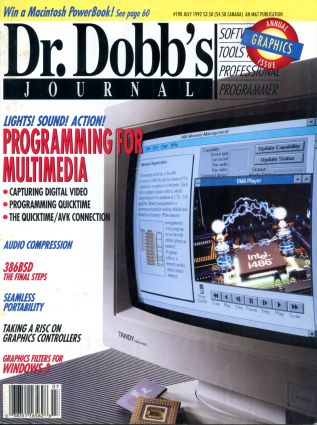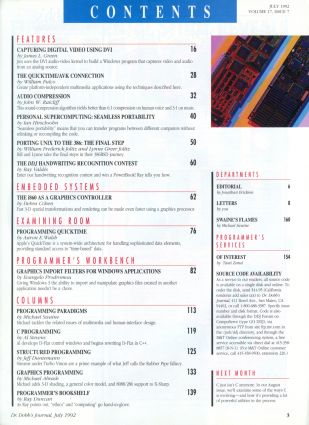
p.6 EDITORIAL
[author : Jonathan Erickson] #Edito
TABLE OF CONTENTS
FEATURES
p.16 CAPTURING DIGITAL VIDEO USING DVI
[author : James L. Green]
Jim uses the DVI audio-video kernel to build a Windows program that captures video and audio from an analog source.
p.28 THE QUICKTIME/AVK CONNECTION
[author : William Fulco]
Create platform-independent multimedia applications using the techniques described here.
p.32 AUDIO COMPRESSION
[author : John W. Ratcliff]
This sound-compression algorithm yields better than 6:1 compression on human voice and 3:1 on music.
p.40 PERSONAL SUPERCOMPUTING: SEAMLESS PORTABILITY
[author : Ian Hirschsohn]
"Seamless portability" means that you can transfer programs between different computers without relinking or recompiling the code.
p.50 PORTING UNIX TO THE 386: THE FINAL STEP
[author : William Frederick Jolitz and Lynne Greer Jolitz]
Bill and Lynne take the final steps in their 386BSD journey.
p.60 THE DR. DOBB'S HANDWRITING RECOGNITION CONTEST
[author : Ray Valdes]
Enter our handwriting recognition contest and win a PowerBook! Ray tells you how.
EMBEDDED SYSTEMS
p.62 THE i860 AS A GRAPHICS CONTROLLER
[author : Debra Cohen]
Fast 3-D spatial transformations and rendering can be made even faster using a graphics processor.
EXAMINING ROOM
p.76 PROGRAMMING QUICKTIME
[author : Aaron E. Walsh]
Apple's QuickTime is a system-wide architecture for handling sophisticated data elements, providing standard access to "time-based" data.
PROGRAMMER'S WORKBENCH
p.82 GRAPHICS IMPORT FILTERS FOR WINDOWS APPLICATIONS
[author : Evangelo Prodromou]
Giving Windows 3 the ability to import and manipulate graphics files created in another application needn't be a chore.
COLUMNS
p.113 PROGRAMMING PARADIGMS
[author : Michael Swaine]
Michael tackles the related issues of multimedia and human-interface design.
p.119 C PROGRAMMING
[author : Al Stevens]
Al develops D-Flat control windows and begins rewriting D-Flat in C++.
p.125 STRUCTURED PROGRAMMING
[author : Jeff Duntemann]
Streams under Turbo Vision are a prime example of what Jeff calls the Rubber Pipe fallacy.
p.133 GRAPHICS PROGRAMMING
[author : Michael Abrash]
Michael adds 3-D shading, a general color model, and 8088/286 support to X-Sharp.
p.139 PROGRAMMER'S BOOKSHELF
[author : Ray Duncan]
As Ray points out, "ethics" and "computing" go hand-in-glove.
DEPARTMENTS
p.8 LETTERS
[author : you]
p.160 SWAINE'S FLAMES
[author : Michael Swaine]
PROGRAMMER'S SERVICES
p.154 OF INTEREST
[author : Tami Zemel]
